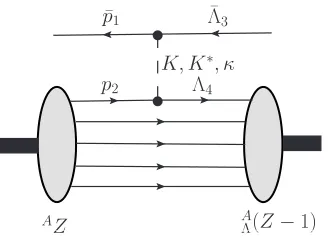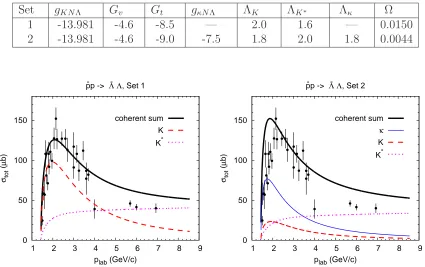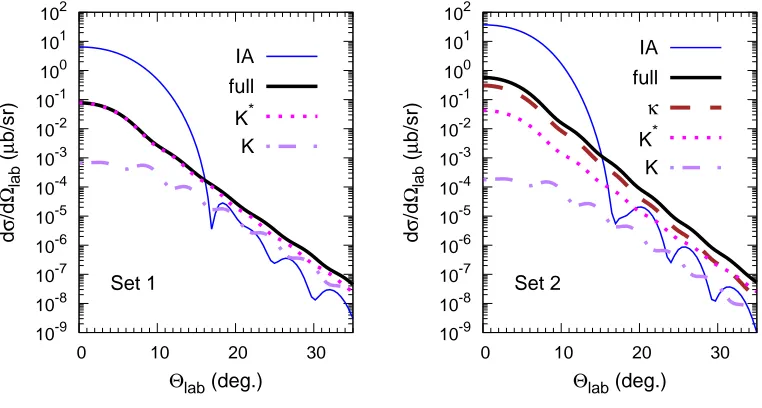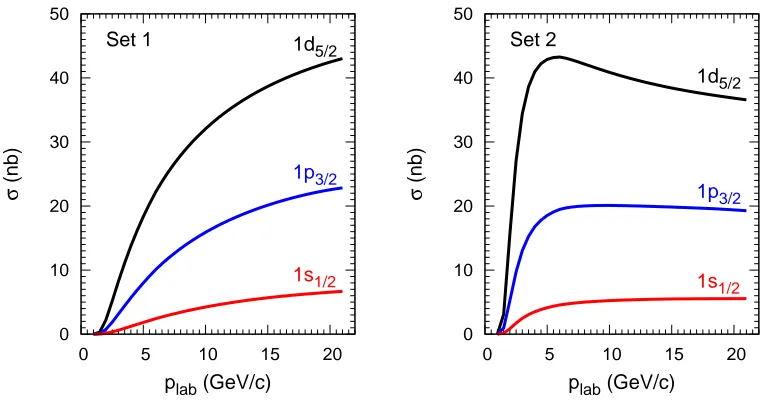arXiv:1709.04370v1 [nucl-th] 12 Sep 2017
Distillation of scalar exchange by coherent hypernucleus
production in antiproton-nucleus collisions
A.B. Larionova,b,c, H. Lenskea
a
Institut f¨ur Theoretische Physik, Universit¨at Giessen, D-35392 Giessen, Germany b
National Research Center ”Kurchatov Institute”, 123182 Moscow, Russia c
Frankfurt Institute for Advanced Studies (FIAS), D-60438 Frankfurt am Main, Germany
Abstract
The total and angular differential cross sections of the coherent process ¯p+AZ →A Λ(Z −
1) + ¯Λ are evaluated at the beam momenta 1.5÷20 GeV/c within the meson exchange model with bound proton and Λ-hyperon wave functions. It is shown that the shape of the beam momentum dependence of the hypernucleus production cross sections with various discrete Λ states is strongly sensitive to the presence of the scalar κ-meson exchange in the ¯pp → ΛΛ amplitude. This can be used as a clean test of the exchange by scalar¯ πK correlation in coherent ¯pA reactions.
Keywords:
¯
p+40Ar→40ΛCl + ¯Λ, meson-exchange model, κ meson
PACS: 25.43.+t, 21.80.+a, 14.40.Df, 11.10.Ef, 24.10.Ht
1. Introduction
Light scalar mesons represent one of the most puzzling areas in the quark/hadron physics as their structure is different from q¯q. In particular, identifying the κ (K∗
0(800))
[1] in various hadronic processes is of importance since this meson is a candidate member of the hypothetical SU(3) octet of scalar mesons with masses below 1 GeV. Apart from ¯κ, the octet-partners of κ are the non-strange isoscalar σ (f0(500)) and isovectorδ (a0(980))
mesons. So far the corresponding particles are only seen as broad resonance-like structures in the 0+-meson spectrum. Theσ, δ,κ and ¯κ are likely theππ,πη,πK andπK¯ resonance
states, respectively. In that sense, the κ exchange can be regarded as an economical way to take into account the correlated πK channel. The κ exchange channel is of particular interest for multi-strangeness baryonic matter in heavy ion collisions and in neutron stars. This channel is also an indispensable part of baryon-baryon interaction approaches utilizing the SU(3) flavour [2] and SU(6) spin-flavour [3] group structures.
The purpose of this letter is to study Λ-hypernucleus production in antiproton-nucleus reactions initiated by the ¯pp → ΛΛ process on the bound proton. The produced Λ is¯
Email addresses: [email protected](A.B. Larionov),
¯
p1 Λ¯3
p2 Λ4
K, K∗, κ
AZ AΛ(Z−1)
Figure 1: The Feynman graph of the AZ(¯p,Λ)¯ A
Λ(Z−1) process. Dashed line represents the propagator of the exchange meson. The grey ellipsoids correspond to the wave functions of the initial ground state nucleusAZ and final hypernucleusA
Λ(Z−1).
captured to one of the shells of the outgoing hypernucleus. The main emphasis is put on the influence of the inclusion of the κ-meson on the reaction cross section.
The full process is sketched in Fig. 1. At momentum transfers <∼1 GeV/c, the ampli-tude of the ¯pp→ΛΛ reaction can be described by¯ t-channel exchanges of the light mesons with strangeness |S|= 1, such as pseudoscalar K, vector K∗, and, probably, hypothetical scalar κ mesons, respectively. If the initial proton and final Λ are bound, the unnatu-ral parity K-exchange is strongly suppressed, since it is pure relativistic effect proceeding through the lower wave function components of either proton or Λ Dirac spinors. Hence the coherent hypernucleus production should filter-out the kaon exchange allowing to ex-clusively address the exchange of the natural parity K∗ and κ. As it will be shown, the scalar κ-exchange contribution to the hypernucleus production cross section is very well visible on the background of smoothly growing with beam momentum vectorK∗-exchange contribution. Therefore the nuclear binding helps to effectively distillate theκmeson from its mixture with kaon exchange in free-space ¯pp→ΛΛ amplitude.¯
2. The Model
We will introduce the K, K∗ and κ exchanges by using the following interaction La-grangians [4, 5, 6]:
In the case of the bound proton and Λ we include their wave functions in the field operators of the Lagrangians Eqs. (1)-(3) and calculate theS-matrix in the second order perturbation theory using Wick’s theorem (cf. Ref. [7]):
S = 2πδ(E1+E2−E3−E4) (2E1V2E3V)1/2
i(MK+MK∗+Mκ), (4)
where Ei, i= 1,2,3,4 are particle energies (see Fig. 1 for notation) and V is the
normal-ization volume. The K, K∗ and κ exchange (noninvariant) partial matrix elements are expressed as respectively. They satisfy the normalization conditions:
Z
is the K∗ meson propagator. We neglected the widths of the K∗ and κ mesons in their propagators as the momentum transfers are space-like (e.g. −t = 0.08÷1.7 GeV2 at
plab = 2 GeV/c). The K∗NΛ vertex function is defined as
Γµ(q) =iGvγµ+
Gt
mN +mΛ
The vertex form factors are chosen in the monopole form:
Similar to Refs. [8, 9, 10] we included in Eqs. (5)-(7) the attenuation factor√Ω to describe the modification of the elementary ¯pp→ΛΛ amplitude due to ISI in the ¯¯ ppchannel and FSI in the ¯ΛΛ channel. This effectively takes into account the absorptive ¯ppand ¯ΛΛ potentials. For simplicity, we assume the attenuation factor Ω to be energy independent. With Ω = 1, Eqs. (5)-(7) correspond to the Born approximation. The Dirac spinors of the antiproton and antilambda plane waves are normalized according to Ref. [7]: ¯u−p,−λu−p,−λ =−2mN(Λ).
The differential cross section in the rest frame of the target nucleus is written as
dσ= 2πδ
where pA and pB are the four-momenta of the initial nucleus (A) and final hypernucleus
(B). The δ function in Eq. (12) takes into account the recoil of the hypernucleus. The cross section is summed over the total angular momentum projections m2 and m4 of the
bound target proton and of the Λ hyperon, respectively, and over the spin projection λ3
of the outgoing ¯Λ. The averaging is taken over the spin projection λ1 of the incoming
antiproton, as expressed by the factor 1/2.
The choice of coupling constants is based on SU(3) relations [11]:
gKNΛ = −gπN N
whereα’s are theD-type coupling ratios. TheπNN coupling constant is very well known, gπN N = 13.4 [12]. The vector ρNN coupling constant is also fixed, Gρv = 2.66, however,
the tensor ρNN coupling constant is quite uncertain, Gρt = 10.9÷20.6 [4]. The σNN
coupling constant can be estimated either from the Bonn model [13] or from the Walecka-type models (cf. [14]). In both cases one obtainsgσN N ≃10. Theα’s for the octets of light
pseudoscalar and vector mesons are reasonably well determined [4, 6]: αP S ≃0.6,αE ≃0,
αM ≃3/4. However, safe phenomenological information on αS is lacking.
Thus, the coupling constants Gt and gκNΛ, the cutoff parameters ΛK,ΛK∗ and Λκ,
and the attenuation factor Ω remain to be determined from comparison with experimental data. We adjusted these parameters to describe the beam momentum dependence of the ¯
pp→ ΛΛ cross section. The two sets of parameters, (1) without¯ κ meson and (2) with κ meson, are listed in Table 1. In the calculations we used the mass mκ = 682 MeV [1].
Table 1: Parameters of the ¯pp→ΛΛ amplitude. The value of¯ gKNΛ slightly differs from -13.3 as given by Eq. (13) and is taken fromK+N scattering analysis of Ref. [15]. The cutoff parameters Λ
K, ΛK∗ and Λκ
are in GeV. The attenuation factors are shown in the last column.
Set gKNΛ Gv Gt gκNΛ ΛK ΛK∗ Λκ Ω
Figure 2: Angle-integrated cross section of the process ¯pp →ΛΛ as a function of the beam momentum¯ calculated without (Set 1) and with (Set 2) inclusion of the κ meson. Full calculations are shown by thick solid lines. Other lines, as indicated, show the partial contributions of theK,K∗ andκexchanges. Experimental data are from Ref. [16].
2 the peak is saturated mostly by the κ exchange. The K∗-exchange contribution grows monotonically with beam momentum and becomes dominant at plab >3÷4 GeV/c. We
note that set 2 gives steeper increasing angular differential cross section towards Θc.m.= 0
atplab = 2.060 GeV/c in a better agreement with experimental data [17] than set 1.
The matrix elements Eqs. (5)-(7) are obtained in the impulse approximation (IA). More realistic calculation should take into account the distortion of the incoming ¯pand outgoing
¯
Λ waves, mostly due to strong absorption of the antibaryons in the nucleus. In the eikonal approximation the incoming ¯p wave is multiplied by the factor
and the outgoing ¯Λ wave is multiplied by
FΛ¯(r) = exp
− 1
2σΛ¯N(1−iαΛ¯N)
+∞ Z
0
dξρ(r+pΛ¯ pΛ¯ξ)
, (17)
whereρ(r) is the nucleon density,σjN is the totaljN cross section,αjN = RefjN(0)/ImfjN(0)
is the ratio of the real-to-imaginary part of the forwardjN amplitude (j = ¯p,Λ). Equations¯ (16),(17) can be obtained by applying the eikonal approximation to solve the Schr¨odinger equation for the scattering of a particle in the external potential (cf. Ref. [18]) which is then replaced by the optical potential in the low-density approximation. The integrands in the matrix elements Eqs. (5)-(7) are then multiplied by Fp¯(r)FΛ¯(r) (cf. Refs. [19, 20]). In numerical calculations we applied the momentum dependent total ¯pN cross section and the ratio αpN¯ as described in Ref. [21]. We assumed that σΛ¯N = σpN¯ at the same
beam momenta which is supported by experimental data on the total ¯Λp cross section at plab= 4÷14 GeV/c [22]. For simplicity we have set αΛ¯N = 0.
The nucleon and hyperon (B = N,Λ) single particle bound state wave functions are determined as solutions of a static Dirac equation with scalar and vector potentials (cf. Refs. [23, 24, 25]):
(−iα·∇+βm∗B(r) +VB(r) +VC(r)−ε)ψB(r) = 0 , (18)
wherem∗
B(r) = mB+SB(r) is the effective (Dirac) mass. Both the scalar (SB) and nuclear
vector (VB) potentials are chosen in the form of superpositions of the classical meson fields,
σ(I = 0, JP = 0+), ω(0,1−), δ(1,0+) and ρ(1,1−), weighted by the strong interaction coupling constants appropriate for the given baryon. The meson fields are parameterized by Woods-Saxon form factors. For protons also the static Coulomb potential (VC) contributes
[25]. We will consider the case of a spherical nucleus. Hence the eigenfunctions of the Dirac equation are characterized by radial, orbital and total angular momentum quantum numbers, n, l, j, respectively, and the magnetic quantum number m≡jz.
In the future ¯PANDA experiment at FAIR the noble gases will be used as targets. Thus as a representative case we consider the reaction ¯p+40Ar → 40
ΛCl + ¯Λ. Using the RMF
approach the parameters of the Woods-Saxon form factors have been chosen to fit the binding energy, single-particle separation energies, and the root-mean-square radii of the nucleon density distributions in the 40Ar nucleus. Under the assumption that the nuclear
potentials do not change after a sudden removal of the valence proton, the Λ-hyperon scalar and vector potentials in the40
ΛCl hypernucleus were obtained by multiplying the scalar and
10-8
Figure 3: Angular differential cross section of the reaction40Ar(¯p,Λ)¯ 40ΛCl at p
lab= 2 GeV/c. Lines show the calculations for Λ in various states, as indicated. Calculations includeκexchange.
10-9
Figure 4: Angular differential cross section of the reaction40Ar(¯p,Λ)¯ 40ΛCl atp
3. Numerical results
The differential hypernuclear production cross sections with the Λ occupying various shells are displayed in Fig. 3. Irrespective of spin-orbit effects 1, the cross sections are
larger for larger hyperon orbital angular momentum, lΛ. We have checked that within the
IA the cross sections at Θlab = 0 for the 1d5/2, 1p3/2 and 1s1/2 hyperon states are nearly
equal. Thus the rise of the cross sections at forward laboratory angles with lΛ is mostly
caused by the nuclear absorption which is diminished with increasing lΛ due to the shift
of the hyperon density distribution to larger radii. The largest cross section is obtained for the 40ΛCl hypernucleus with Λ in the 1d5/2 state. The differential angular distribution
for this case is analyzed in more detail in Fig. 4. From the comparison of the full and IA calculations we observe that the absorption of ¯p and ¯Λ has a quite significant effect: it reduces the cross section drastically, amounting at forward angles to about two orders of magnitude, and smears out the diffractive structures. Similar effects of the absorption are present also for the other Λ states.
A deeper insight into the production mechanism is obtained by decomposing the total reaction amplitude into different meson exchange parts. From the partial meson exchange contributions, shown in Fig. 4, it is remarkable that for Set 1 the kaon contribution is small and the spectrum is dominated by K∗, however, from Fig. 2 one would expect the opposite. This surprising result can be understood by the fact that the momentum transfer to the ¯Λ is provided by the nucleus as a whole while the produced Λ is almost at rest. The exchange by pseudoscalar meson is suppressed in this case since it proceeds through the lower components of the proton and hyperon Dirac spinors2 which are suppressed by
factors ∼ 1/mBR, where R is the nuclear radius. In contrast, in the case of the free
space ¯pp → ΛΛ process the Λ is produced with finite momentum. Therefore the upper¯ and lower components of its Dirac spinor are of comparable magnitude which favours the pseudoscalar meson exchange.
The situation is very different in the case of Set 2. Here, κ plays the dominant role both for the free scattering ¯pp→ΛΛ and for the hypernucleus production since the scalar¯ exchange is not suppressed in the recoilless kinematics.
As we see from Fig. 5, the cross section of coherent hypernucleus production in different states is much larger when the κ exchange is included. This is pure quantum coherence effect since the angle-integrated ¯pp→ ΛΛ cross sections differ by¯ ∼15% only at plab = 2
GeV/c (Fig. 2) while the hypernuclear production cross sections differ by almost one order of magnitude for Set 1 and Set 2.
The robust signal of the κ exchange is visible in the beam momentum dependence of the hypernucleus production cross section shown in Fig. 6. In calculations without κ the
1There is a strong difference between the cross sections withj
Λ =lΛ±1/2, so that the cross sections for the larger value ofjΛare much larger at forward angles. This effect arises from the detailed structure of the Fourier transforms of the transition form factors in the matrix elements Eqs. (5)-(7) and its study is beyond the scope of this work.
0
Figure 5: Spectral distribution of Λ bound states in a 40ΛCl hypernucleus produced in coherent ¯p40Ar collisions atplab= 2 GeV/c. The angle-integrated cross sections for the hypernucleus production in 1s1/2,
1p3/2 and 1d5/2 states have been folded by Gaussians of width ΓF W HM = 1.5 MeV which is a typical
experimental energy resolution. Thick and thin solid lines correspond to the results obtained with (Set 2) and without (Set 1)κexchange, respectively.
0
Figure 6: Beam momentum dependence of the40
K∗ exchange dominates and produces a smoothly growing cross section with increasing beam momentum. The κ meson dominates at moderate beam momenta∼1.5÷3 GeV/c (Fig. 2). This leads to the characteristic shoulder in plab-dependence of the cross section
of the hypernucleus production and even to the appearance of the maximum for the 1d5/2
Λ state. We have checked that within the IA the maximum in the beam momentum dependence in the calculation including κ becomes even more pronounced. Hence this maximum is a clean manifestation of the κ exchange and not an artifact of particular approximation for the ISI/FSI effects.
4. Summary and outlook
In the present work, the calculations of the coherent hypernucleus production in ¯pA collisions have been performed. We have demonstrated that the pseudoscalarKexchange is strongly suppressed for the bound Λ states. Thus the hypernucleus production is governed by the natural parity strange meson exchanges. Keeping only vectorK∗ exchange produces the smooth and structure-less increase of the cross sections of the hypernucleus production with beam momentum. However, including the scalarκexchange leads to the sharp change of the slope of the beam momentum dependence of the hypernucleus production cross sections from increase to saturation between 4 and 6 GeV/c and even to the appearance of the pronounced maximum in the case of 1d5/2 Λ state. Hence we suggest that the
measurement of the coherent Λ-hypernucleus production cross section in ¯pAcollisions can be used as a test of possible exchange by the scalar πK correlation. These studies can be done at the planned ¯PANDA experiment at FAIR and at J-PARC. Note that the antiproton beam gives the unique opportunity to study t-channel meson exchanges, as, e.g. in the case of hypernuclear production in (π+, K+) reactions the process is governed bys-channel
baryon resonance excitations [23].
With appropriate extensions the methods used here can be applied to the production of hyperons in low-energy unbound states, thus allowing in principle to explore elastic scattering of Λ and Σ hyperons on nuclei. Experimentally, such reactions could be identified e.g. by observation of the recoiling target fragment of mass number A−1. This may also help to clarify further the still undecided question whether there are bound Σ hypernuclei. Of large interest is to establish the existence of the ¯Λ-hypernuclei which can be produced in the process (¯p,Λ) with the capture of ¯Λ in the residual nucleus. However, that production process requires a large momentum transfer to the struck proton (backward scattering). In this case, the description based on the reggeized t-channel meson exchange model should be more appropriate for the elementary ¯pp→ΛΛ amplitude.¯
Charmed hadrons embedded in- or interacting with nuclei represent another related field of studies. The coherent Λ+
c-hypernuclei production in (¯p,Λ¯−c) processes has been
explored theoretically recently in Ref. [26]. The underlying ¯pp → Λ¯−
c Λ+c reaction on
the bound proton has been described with a t-channel exchange by pseudoscalar D0 and
vector D∗0 [9]. Overall, the uncertainties in the charm sector are quite large due the lack
D∗
0(2400) meson is possible in this case and can be distilled by using the Λ+c -hypernuclei
production in a similar mechanism.
Acknowledgements
This work was supported by the Deutsche Forschungsgemeinschaft (DFG) under Grant No. Le439/9. Stimulating discussions with M. Bleicher and M. Strikman are gratefully acknowledged.
References
[1] C. Patrignani et al. (Particle Data Group), Chin. Phys. C40, 100001 (2016).
[2] R. G. E. Timmermans, T. A. Rijken, and J. J. de Swart, Phys. Rev.D45, 2288 (1992).
[3] J. Haidenbauer and U.-G. Meissner, Phys. Rev.C72, 044005 (2005).
[4] M. K. Cheoun, B. S. Han, I. T. Cheon, and B. G. Yu, Phys. Rev.C54, 1811 (1996).
[5] K. Tsushima, A. Sibirtsev, A. W. Thomas, and G. Q. Li, Phys. Rev.C59, 369 (1999), [Erratum: Phys. Rev.C61,029903(2000)].
[6] B. S. Han, M. K. Cheoun, K. S. Kim, and I.-T. Cheon, Nucl. Phys.A691, 713 (2001).
[7] V. B. Berestetskii, E. M. Lifshitz, and L. P. Pitaevskii, Relativistic Quantum Theory
(Pergamon Press, 1971).
[8] N. J. Sopkovich, Nuovo Cimento 26, 186 (1962).
[9] R. Shyam and H. Lenske, Phys. Rev. D90, 014017 (2014).
[10] R. Shyam and H. Lenske, Phys. Rev. D93, 034016 (2016).
[11] J. J. de Swart, Rev. Mod. Phys. 35, 916 (1963), [Erratum: Rev. Mod. Phys.37,326(1965)].
[12] O. Dumbrajs, R. Koch, H. Pilkuhn, G. C. Oades, H. Behrens, J. J. De Swart, and P. Kroll, Nucl. Phys. B216, 277 (1983).
[13] R. Machleidt, K. Holinde, and C. Elster, Phys. Rept. 149, 1 (1987).
[14] G. A. Lalazissis, J. K¨onig, and P. Ring, Phys. Rev. C55, 540 (1997).
[15] R. B¨uttgen, K. Holinde, A. M¨uller-Groeling, J. Speth, and P. Wyborny, Nucl. Phys.
A506, 586 (1990).
[17] B. Jayet, M. Gailloud, P. Rosselet, V. Vuillemin, S. Vallet, M. Bogdanski, E. Jeannet, C. J. Campbell, J. Dawber, and D. N. Edwards, Nuovo Cim. A45, 371 (1978).
[18] L. D. Landau and E. M. Lifshitz, Quantum Mechanics (Pergamon Press, 1965).
[19] H. Bando, T. Motoba, and J. Zofka, Int. J. Mod. Phys. A5, 4021 (1990).
[20] L. L. Frankfurt, M. I. Strikman, and M. B. Zhalov, Phys. Rev. C50, 2189 (1994).
[21] A. B. Larionov and H. Lenske, Nucl. Phys. A957, 450 (2017).
[22] F. Eisele et al., Phys. Lett.B60, 297 (1976).
[23] S. Bender, R. Shyam, and H. Lenske, Nucl. Phys. A839, 51 (2010).
[24] N. K. Glendenning, D. Von-Eiff, M. Haft, H. Lenske, and M. K. Weigel, Phys. Rev.
C48, 889 (1993).
[25] C. M. Keil, F. Hofmann, and H. Lenske, Phys. Rev. C61, 064309 (2000).



